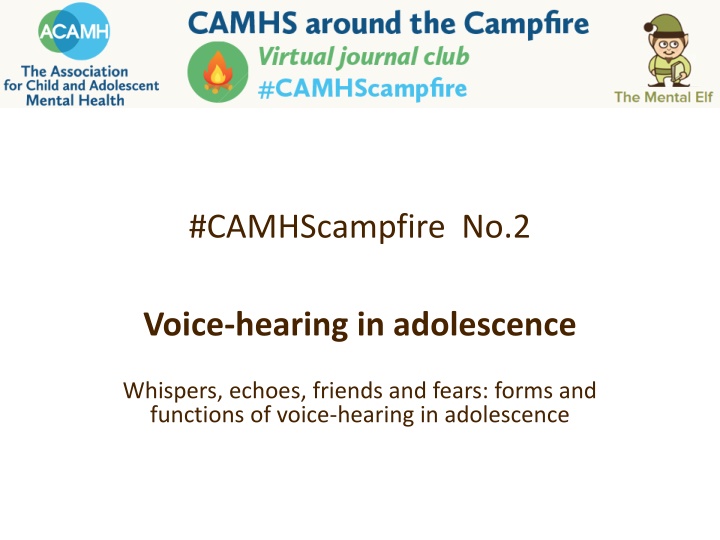
Voice-Hearing in Adolescence: Findings and Implications
Delve into the world of voice-hearing in adolescence through the lens of a research study exploring young people's experiences, challenges, and insights. Learn about the methodology employed, critical appraisals made, and the importance of advancing understanding in this area for policy and practice guidelines.
Download Presentation

Please find below an Image/Link to download the presentation.
The content on the website is provided AS IS for your information and personal use only. It may not be sold, licensed, or shared on other websites without obtaining consent from the author. If you encounter any issues during the download, it is possible that the publisher has removed the file from their server.
You are allowed to download the files provided on this website for personal or commercial use, subject to the condition that they are used lawfully. All files are the property of their respective owners.
The content on the website is provided AS IS for your information and personal use only. It may not be sold, licensed, or shared on other websites without obtaining consent from the author.
E N D
Presentation Transcript
#CAMHScampfire No.2 Voice-hearing in adolescence Whispers, echoes, friends and fears: forms and functions of voice-hearing in adolescence
Agenda 1. Introductions 2. What is the research question? 3. Is this evidence valid? 4. What are the findings? 5. Is this valid, important evidence helpful? 6. Closing remarks Please use the chat window to post any questions you have.
Hello! Andre Tomlin (Chair, The Mental Elf) Rebecca Burns (McPinFoundation Young Person s Network) Prof Emmanuelle Peters (Professor & clinical psychologist) Dr. Sarah Parry (Lead researcher) Douglas Badenoch (Information specialist, Minervation) Dr. Steph Lewis (Psychiatrist and researcher, ACAMH) Please use the poll to tell us about yourselves!
The research question The study aimed to advance the theoretical and phenomenological understanding of voicehearing for an under-represented group of young people with the objective of informing policy, research and practice guidelines. More about the Young Voices study @youngvoicestudy or http://bit.ly/39qoBc6
Study methods Participants were recruited via social media, health trusts and support groups. The researchers developed a specific platform for research engagement to safeguard confidentiality. CYP aged 13-18 were asked to opt-in to the study if they identified as hearing voices that others could not. They did not have to have a clinical diagnosis or be connected to a mental health service. The analytic method incorporated narrative and phenomenological analyses of the data from answering the study questions. The researchers involved CYP with lived experience of hearing voices in the development of the online platform and also in evaluating the data.
Critical appraisal CAN T TELL CASP Checklist items YES NO X 1) Was there a clear statement of the aims of the research? 2) Is a qualitative methodology appropriate? 3) Was the research design appropriate to address the aims of the research? 4) Was the recruitment strategy appropriate to the aims of the research? 5) Was the data collected in a way that addressed the research issue? X X X X X 6) Has the relationship between researcher and participants been adequately considered? 7) Have ethical issues been taken into consideration? 8) Was the data analysis sufficiently rigorous? 9) Is there a clear statement of findings? 10) How valuable is the research? X X X X
Critical appraisal Self-selected sample + only 76% completed the survey to the end Caution needed re: generalisability Foucauldian-informed Narrative Analysis + phenomenological analysis = Addresses issues of reflexivity, power and control How participants understand their experiences
Study findings Half of participants had not sought healthcare or community-based support Participants reported negative (56%), positive (23%) and mixed (21%) emotions in respect of their hearing voices.
Study findings There were important differences between positive and negative voices in terms of form and function. They tended to find it more difficult to describe and understand negative voices.
Implications Hearing voices has an impact beyond those with a clinical diagnosis Hearing voices can have positive impacts as well as negative Implications of the study platform: This survey helped me get my feelings out. Thank you for giving me a place to talk openly about my experiences!
